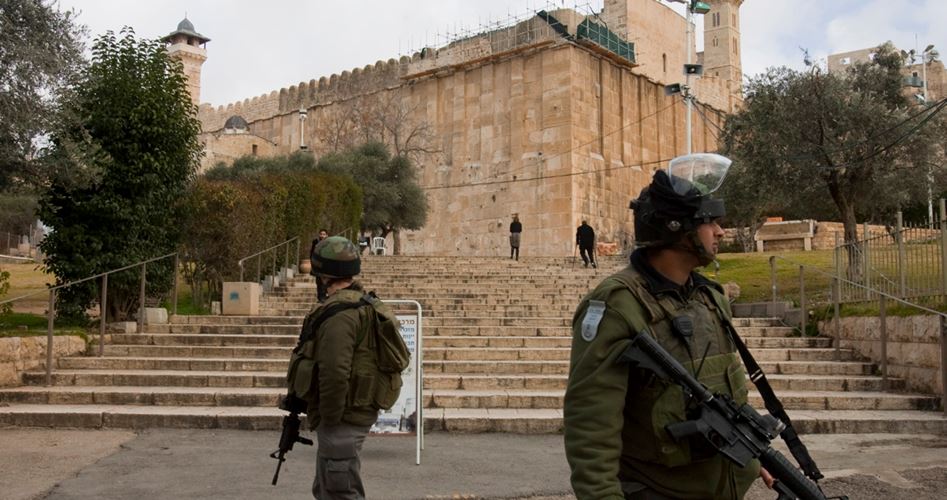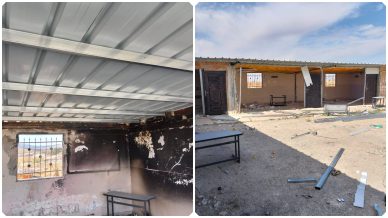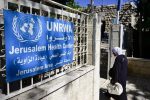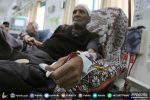As Muslims go half the way through the holy month of Ramadan residents of Al-Khalil in the southern West Bank recall the massacre of the Ibrahimi Mosque which took place 23 years ago and was carried out by a terrorist Israeli settler named Baruch Goldstein against Palestinian worshipers during the dawn prayers in the courtyard of the Ibrahimi Mosque.
Details of the massacre
According to eyewitnesses who survived the bloodbath the massacre took place while worshipers were kneeling down for prayer at the dawn prayer. The terrorist settler Baruch Goldstein carried out his massacre by shooting about 500 bullets killing 29 and injuring 150 others. When Goldstein was trying to fill his gun again with bullets worshipers attacked and killed him.
At the time of the massacre Israeli occupation soldiers who were present at mosque closed its doors to prevent worshipers from running for their lives. They also prevented those coming from outside for help to reach the area to save the wounded. Later more Palestinians were killed by Israeli soldiers outside the mosque and during the funerals of the martyrs. The total number of Palestinian killed reached 50 29 of whom were killed inside the mosque.
This massacre stirred an angry reaction in occupied Palestine which included all cities from the south to the north. It resulted in widespread popular clashes and large-scale confrontations between the Palestinians and the occupation forces and settlers. The number of Palestinian martyrs who were reported as a result of that popular anger at the Israeli occupation soldiers reached 60.
Memories of families
Despite the passing of 23 years since the massacre took place the people of Al-Khalil are sill recalling and reviving these wounds so that their children don’t forget the revenge of their ancestors and grandparents.
The tears of Palestinian mother Um Mujahid Nimir does not stop during Ramadan as she recalls the last prayer performed by her son Nimr Mujahid at the Ibrahimi Mosque on 15th day of Ramadan in 1994: “The occupation imposed a lasting grief and pain on us. What makes us more patient is that his martyrdom was on Friday during Ramadan while he was performing the dawn prayer.”
She added “The joy of Ramadan has gone for many families whose children were killed in that massacre.”
The Ibrahimi Mosque targeted
The Israeli occupation forces closed the Ibrahimi Mosque and the Old City of Al-Khalil for six months at the pretext of investigating the crime and formed a one-party committee called ‘Shamgar’ to investigate the massacre and its causes.
The committee published several recommendations including the division of the Ibrahimi Mosque into two parts one for Muslims and one for Jews and imposed more restrictions on the lives of the Palestinian citizens of the Old City placing strict monitoring on the mosque and giving the Jews the right to sovereignty over much of the mosque (about 60% of it in an attempt to Judaize and seize it). The occupation has repeatedly prevented the call to prayer at the mosque.
The part of the mosque which is under Israeli control includes mausoleums tombs of prophets including the tomb of Prophet Jacob and his wife the tomb of Prophet Abraham and his wife Sarah and the tomb of Prophet Joseph in addition to the courtyard of the mosque.
The Israeli occupation authorities then installed cameras and electronic gates on all entrances and closed most of the roads leading to the mosque in the face of Muslims except for one gate with high security measures in addition to the closure of the markets of Hesba Al-Khalil and Shaheen and Al-Shuhada and Al-Sahla streets thus separating the Old City from its surroundings.
The Israeli occupation forces have stepped up security measures at the entrance of the mosque where they installed an electronic gate known as the cage gate in addition to erecting checkpoints at Alashraf Gate. All of this was designed in an area that does not exceed 200 square meters in addition to installing 26 cameras inside the mosque. All roads leading to the mosque were closed except for one road under Israeli control.
The ‘Shamgar’ Committee recommended opening the mosque in front of Muslims only for 10 days throughout the year as well as 10 days for Jews only.
Today as a result of the division of the mosque after the massacre the mosque has turned into military barracks through which worshipers undergo more than one security check before they stand at the hands of their Lord. The mosque has become a permanent point of contention and tension due to the aggression and provocations of the Israeli occupation and its settlers.













